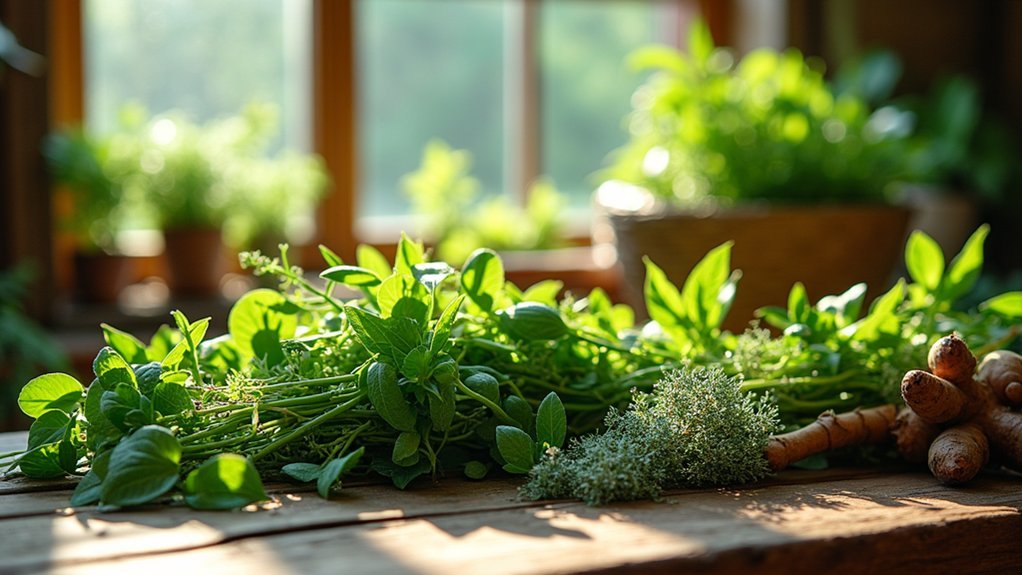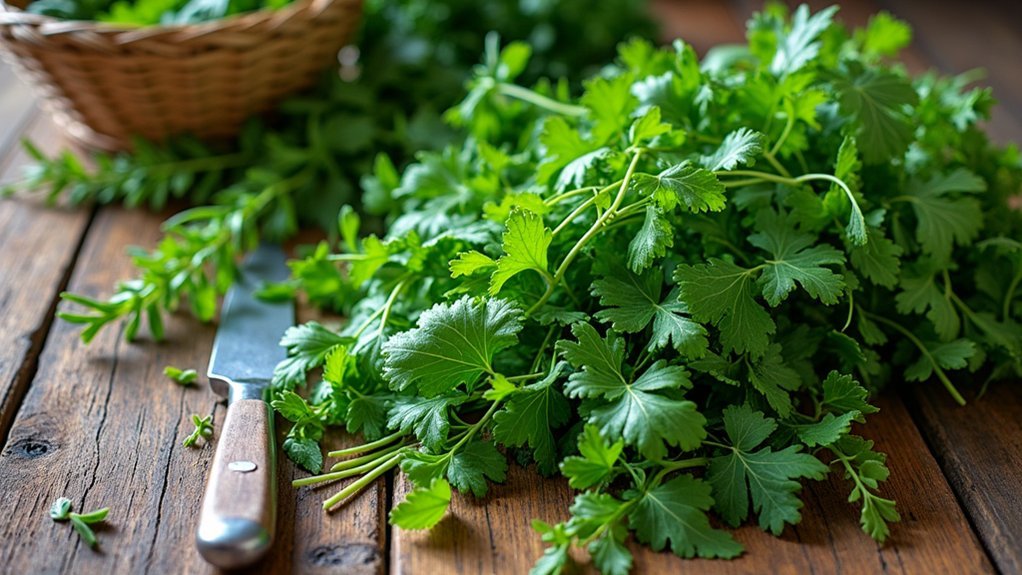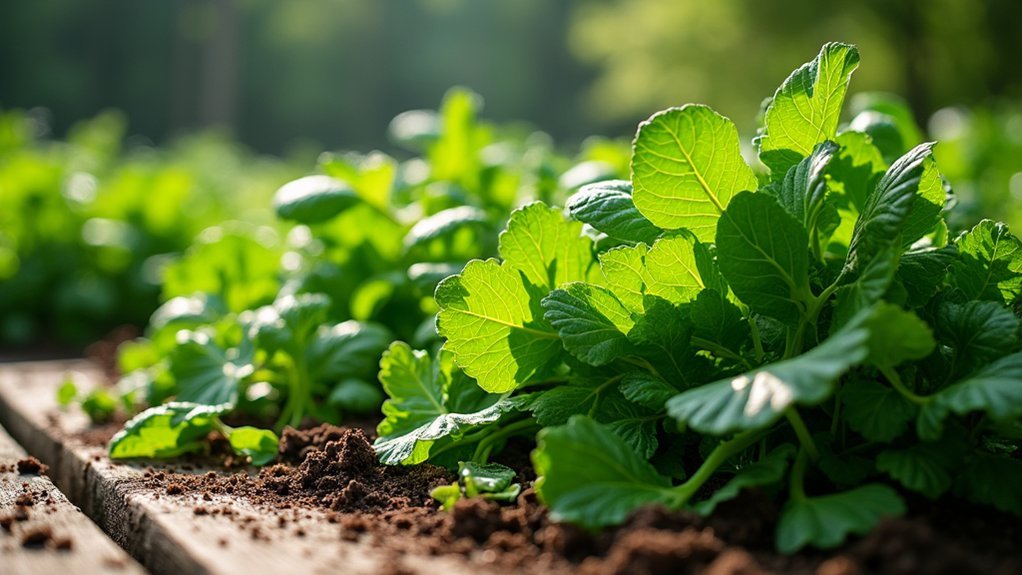Properly cleaning foraged plants is essential for safe consumption. Start by rinsing your harvest under cool water to remove dirt and debris, then soak in a solution of 1 part vinegar to 2 parts water for 15-20 minutes to eliminate bacteria. For leafy greens, use a salad spinner to remove excess moisture, while berries may need gentle brushing. After cleaning, dry thoroughly before storing or cooking. The journey from forest to table requires these simple but vital steps for wild food safety.
Clean Wild Plants: From Forest to Kitchen

When you bring wild plants home from your foraging adventures, proper cleaning becomes your essential next step in the journey from forest to kitchen.
After careful plant identification in the field, you'll need to thoroughly clean foraged plants to remove dirt, bugs, and environmental contaminants.
Start by rinsing your wild greens under cool running water, then soak them to loosen stubborn debris. For extra safety, use a vinegar solution to eliminate bacteria.
Once clean, dry them thoroughly with a salad spinner or towels to remove excess moisture that could cause spoilage.
Store your cleaned treasures in breathable bags in the refrigerator with a damp paper towel to maintain freshness.
For longer preservation, dry herbs and store them in air-tight glass jars, where they'll keep their flavor for up to a year.
The Forager's Field Guide to Plant Identification
Anyone venturing into the wilderness to harvest wild edibles must first master the critical skill of plant identification.
Investing in reliable field guides with clear photos and descriptions is your first step in distinguishing edible plants from toxic lookalikes.
You'll need to familiarize yourself with basic botanical terms to understand leaf patterns, flower structures, and growth habits.
Remember that seasonal availability affects when foraged species are most abundant and identifiable.
Don't forage alone when starting out.
Join local foraging groups or workshops where experienced foragers share valuable knowledge and provide hands-on identification practice.
These communities offer insights you won't find in books alone.
For additional verification, use plant identification apps while in the field—they're helpful supplements to traditional guides when confirming your findings before harvesting.
Essential Tools for Urban Wild Plant Collection

Five essential tools will transform your urban foraging experience from amateur to efficient.
Start with a sturdy basket or cloth bag that lets your wild plants stay fresh and uncrushed during transport.
A proper foraging container isn't just practical—it's respect for nature's bounty and the difference between pristine finds and wilted disappointments.
Don't forget quality garden scissors or a sharp knife for cleanly harvesting plants without damaging roots or surrounding vegetation.
A reliable field guide or plant identification app is non-negotiable—it guarantees you're collecting edible species and avoiding toxic lookalikes.
For root harvesting, pack a small trowel that minimizes soil disruption while protecting the ecosystem.
Finally, bring gloves to protect your hands when handling plants with thorns or irritants.
With these tools for urban wild plant collection, you'll streamline the process from harvesting to cleaning your foraged treasures at home.
Pre-Cleaning Assessment: Safety & Sustainability
Before you even touch a wild plant, conducting a thorough pre-cleaning assessment guarantees both your safety and environmental sustainability.
First, confirm you've correctly identified each species, as misidentification can lead to harvesting toxic lookalikes.
Verify you're foraging in organic areas free from chemical contamination. Stay away from roadsides, industrial zones, and locations where fertilizers or pesticides might've been applied.
Watch for animal scat nearby, which can indicate potential biological contamination of plants.
Practice ethical foraging by harvesting selectively and sparingly. Take only what you'll use, leaving plenty for wildlife and plant regeneration.
This sustainable approach preserves delicate ecosystem balances and verifies wild plants remain available for future generations.
Your careful assessment before collection forms the foundation of responsible wild food preparation.
Soil Removal Techniques for Leafy Greens & Herbs

Once you've properly identified and ethically harvested your wild plants, proper cleaning becomes your next priority.
Begin by rinsing your wild herbs and leafy greens under cool water to remove surface dirt and contaminants. Then, submerge them in a clean sink or bowl filled with cold water for about 10 minutes to loosen stubborn soil particles.
For enhanced cleanliness, consider soaking your foraged treasures in a vinegar solution (1 part white vinegar to 2 parts distilled water), which effectively eliminates bacteria without affecting flavor.
Delicate wild herbs benefit from gentle cleaning with a soft brush to preserve their integrity.
Finally, use a salad spinner to remove excess moisture and any remaining dirt particles. This thorough cleaning process guarantees your wild harvest is safe and ready for culinary use.
Insect & Debris Management for Flowers & Berries
Wild flowers and berries pose unique cleaning challenges compared to leafy greens due to their delicate structures and tendency to harbor insects. To properly clean these wild edibles, rinse them under cool running water to remove surface dirt and debris.
For stubborn insects, soak your harvest in saltwater for 10 minutes—this helps dislodge hidden pests without compromising texture.
- Imagine tiny beetles scurrying from between raspberry drupelets as water washes over them
- Picture delicate violet petals spreading open under gentle water pressure, revealing hidden soil
- Visualize using a soft brush to clean textured berries, dirt falling away with each stroke
- See yourself carefully inspecting each flower petal, holding it to the light to spot any remaining insects
Don't soak flowers too long or they'll become mushy and lose their appeal.
Vinegar Soaks & Natural Cleaning Solutions

Although many foragers rely on water alone, vinegar soaks provide superior cleaning power for wild edibles.
Create an effective solution by mixing 1 part white vinegar with 2 parts distilled water to eliminate bacteria and unwanted residues from your foraged plants. Simply submerge your wild harvest for 15-20 minutes, then rinse thoroughly under cool water.
For insect removal, saltwater offers an excellent natural alternative. Soak your plants for 10 minutes before rinsing to guarantee all critters are gone.
For delicate specimens like mushrooms, avoid full immersion—instead, use a gentle spray nozzle to clean without compromising texture.
Drying Methods to Preserve Foraged Treasures
After you've cleaned your wild harvest, proper drying becomes essential for long-term preservation of your foraged treasures.
You'll find several effective drying methods to maintain the flavor and medicinal properties of your wild plants.
- Hang bunches of leaves and flowers in a dark, well-ventilated space to air dry naturally over several days to weeks.
- Set your food dehydrator to low heat (95-115°F) for controlled drying that preserves nutrients and flavors.
- Use your oven on its lowest setting with the door slightly ajar, monitoring carefully to prevent burning.
- Try the quick microwave method by placing herbs between paper towels and heating in short bursts.
Store your dried foraged finds in airtight glass jars away from light and moisture, ensuring they'll remain potent for up to a year.
Frequently Asked Questions
How to Wash Wild Greens?
Rinse your wild greens under cool running water, then soak them in cold water for 10 minutes. Rinse again to remove all dirt and insects. Dry thoroughly with a salad spinner or towels before storing.
How to Clean Edible Plants?
Rinse your edible plants under cool water, then soak them in a 1:2 vinegar-water solution for 15-20 minutes. Dry them in a salad spinner and inspect thoroughly before storing in breathable bags with damp paper towels.
How Do You Preserve Wild Greens?
You can preserve wild greens by blanching in salted water, freezing in olive oil, dehydrating, or pickling. Each method extends shelf life while maintaining nutritional value, with proper storage giving you edible greens year-round.
Can You Eat Wild Plants?
Yes, you can eat wild plants, but you must identify them accurately first. Many like dandelions and purslane are nutritious, but always harvest from uncontaminated areas and follow ethical foraging practices for safety.
In Summary
You've now learned how to transform wild plants into kitchen-ready ingredients. As you venture into forests and urban green spaces, remember that responsible foraging means taking only what you need and cleaning properly. Your basket of wild treasures isn't just food—it's a connection to ancient traditions. With these skills, you'll turn previously overlooked plants into delicious, nutritious additions to your table.





Leave a Reply